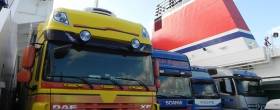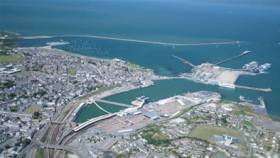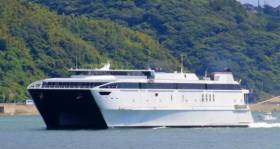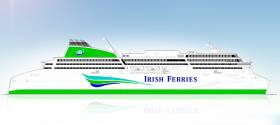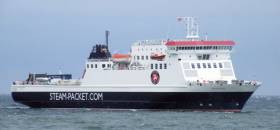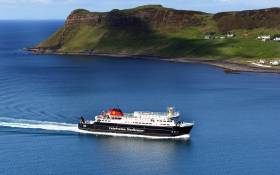Displaying items by tag: Ferry news
Encouraged by Sustainability Report Findings at Stena Line
#CO2reduced - Strategic efforts to reduce its environmental footprint at Stena Line is well on course according to a recent company report. Last year the ferry operator cut emissions of sulphur by 53%.
Stena AB’s Sustainability Report for 2015, which was recently published, shows reduced fuel consumption and lower emissions for the shipping companies within the shipping group. Stena Line has exceeded its targets for reduction of emissions of both sulphur and CO2.
One of the largest changes to affect the shipping industry was introduced in 2015 with tough new regulations on sulphur emissions being laid down for ferry operators in Northern Europe. This regulation means that the permitted emission levels of sulphur from vessels has been reduced from a maximum 1 per cent to 0.1 per cent within the SECA area from January 1st 2015.
For Stena’s shipping companies, with 93 vessels operating all over the world, the new rules have resulted in a reduction of over 4,000 tonnes of sulphur from 2014 to 2015, which represents an impressive 15 per cent reduction. For Stena Line’s 34 vessels operating in Europe, 24 of which operate within the SECA area, the total emission of sulphur has been reduced by 53 per cent.
Carl-Johan Hagman, CEO at Stena Line, said: “Focusing on sustainability is not only a priority for Stena Line, but for the entire industry which needs long term sustainable fuel options to maintain its competiveness. We are currently conducting several initiatives looking at alternative fuels within Stena. Our Methanol Project on Stena Germanica is one example. We are also looking at battery powered vessels, which is now starting to become an interesting option for shipping.
“Since 2015 Stena’s shipping companies have been delivering a dedicated program called the Energy Saving Programme (ESP), to reduce fuel consumption. The target is a reduction of 2.5 per cent annually and the result for 2015 was a reduction of 2.8 per cent. For Stena Line the efforts led to a reduction of fuel consumption of 4 per cent per nautical mile and a reduction of CO2 emissions of 2.5 per cent per nautical mile,” concluded Carl-Johan.
Erik Lewenhaupt, Head of Sustainability, Stena Line, said: “We have a broad scope and are currently driving several different initiatives in a bid to reduce our fuel consumption within ESP. It covers everything from changing bulbs and propellers to enabling our ferries to sail with reduced water resistance. Other initiatives include using digital solutions such as our Fuel Management System, where we collect a huge amount of data from the systems onboard our 34 ferries which is them analysed and used to optimise our day to day operations. We have set an ambitious target of trying to reduce CO2 emissions by 35% per nautical mile by 2030.”
#BREXITholyhead? - The United Kingdom's referendum on membership of the European Union is rapidly approaching, writes BBC News, but what does it mean for those places that find themselves at the centre of the debate - whether they want to be or not?
George Herd has been in the port town of Holyhead on Anglesey - and across the Irish Sea to the Republic of Ireland's capital, Dublin.
It is pub quiz question time: What links a truckers' rest and odds of 4/11 that the UK will vote to stay in the EU come the vote on June 23? That was the price on offer at the weekend from a well-known High Street bookies chain you can find in Holyhead on Anglesey.
The link? The founder and owner of the bookmakers also happens to be the co-owner of the Road King truck stop and cafe on the edge of the town. There, staff have just thrown a party to celebrate the venue's first birthday, and the £7m gamble to build it in the first place.
It was a gamble based on the simple premise: location, location, location. For much more on the BREXIT debate, click here.
#FerrytoUSnavy - Irish Continental Group (ICG) which acquired a fastferry for $13.25 million last month has taken delivery this week of the HSC (high-speed craft) Westpac Express from BALI Westpac 2006, LLC, writes Jehan Ashmore.
The HSC has been onward delivered by ICG to Sealift LLC who has in turn chartered the fastferry to the U.S Navy's Military Sealift Command (MSC), a government organisation that controls the replenishment and military transport ships of the navy.
The charter is subject to usual US government procurement regulations and is fixed for a firm 4 month period to 30 September, with charterer's options to extend the charter period to a maximum of 59 months in total.
The vessel was built in 2001 by Austal Ships, Australia. It has a gross tonnage of 8,403 tonne, passenger capacity of 900 and a car carrying capacity of 182 units. Afloat adds that Irish Sea operator, the Isle of Man Steam Packet's fastferry Manannan built by a rival of Austal, InCAT based in Hobart, Tasmania, had also served a career with the US Navy's MSC.
Westpac Express is not the only ICG vessel on charter as the former Irish Sea ropax Isle of Innisfree currently the Kaitaki is bareboat chartered ( i.e. without crew) to a third party in New Zealand.
The custom-built 22,365 tonnes cruiseferry 'Innisfree' which became ICG's first newbuild since acquiring the ailing state-owned B&I Line, began operating for Irish Ferries until replaced by larger tonnage.
For almost the last decade Kaitaki has operated Interislander's Wellington-Picton route having entered service in August 2006. The 1,650 passenger/ 600 car/ 108 truck cruiseferry serves the Cook Strait service linking the north and south islands.
#NewFerry- Irish Continental Group (ICG) has entered into an agreement, with German company Flensburger Schiffbau-Gesselschaft & Co.KG (FSG) to build a cruise ferry for ICG at a contract price of €144 million.
Afloat adds that the proposed design of the newbuild strongly resembles that of current flagship Ulysses.
The new cruise ferry will accommodate 1,885 passengers and crew, with 435 cabins and with capacity for 2,800 lane metres of freight (165 freight vehicles) plus an additional dedicated car deck with capacity for 300 passenger cars.
The Agreement between ICG and FSG provides that the cruise ferry is scheduled for delivery in May 2018. 20% of the contract price will be paid in instalments during the construction period. The balance of 80% will be paid on delivery. ICG intend to utilise a combination of existing cash resources and loan facilities to finance the cruise ferry. The pre-delivery instalment payments to FSG will be protected by means of bank guarantees.
This cruise ferry will be designed and built to the highest standards of cruise shipping, and equipped with efficiency and comfort in mind. Emissions scrubber technology (not included in the above price) and ballast water systems will meet current and known future environmental regulations and will deliver optimal fuel consumption while minimising related costs. The cruise ferry will be powered by four main engines delivering 33,600KW of power which will ensure a high degree of service reliability similar to that already achieved by the existing owned fleet of modern cruise ferries.
The cruise ferry will be designed to best meet the operational seasonality of our business. This flexibility in design includes the ability to service all of Irish Ferries existing routes, and will provide even greater route management options. The cruise ferry will also adhere to Ice Class specification which will allow for a wide geographic area of operation.
Passenger facilities will be spread over 4 decks and will offer a choice of 435 cabins to include suites with their own private external balconies, along with deluxe and standard class accommodation. In addition to a superb choice of bars, restaurants (to include both á la carte and self-service options), special provision has been made for premium Club Class passengers, with a dedicated lounge featuring private access direct from the vehicle decks. A choice of state of the art entertainment options and cinemas, dedicated facilities for freight drivers, as well as retail outlets and onboard facilities for pets, will ensure that all our passengers will be comfortable and engaged throughout their journey.
It is likely that this new cruise ferry will be introduced on routes served by the chartered ship MV Epsilon, (currently year round services Dublin - Holyhead midweek, and Ireland - France on weekends). The cruise ferry will provide additional freight and tourism capacity on both routes and will deliver a much enhanced onboard experience for all customers. In addition to increased capacity, the cruise ferry will deliver significant cost savings to the group and improved route and fleet management efficiencies.
Referring to the announcement Eamonn Rothwell, Chief Executive Officer, commented that; "This investment underpins the confidence the Group has in both the freight and passenger tourism markets between Ireland, Britain and France. The construction of a cruise ferry of this size will offer a premium experience for all our customers, in line with our commitment to deliver the best in service, in reliability and flexibility across all our routes. We also expect to be well positioned to accommodate the changing expectations of our customers, and to benefit from significant operational and financial benefits following the delivery in 2018."
#FerryInvestment -The Isle of Man Steam Packet Company has set out its vision for the future of services that includes investment of £170m in new vessels, port facilities and increased year-round passenger capacity.
Also as part of plans to improve ferry services are fare reductions, more special offers and a new frequent traveller scheme.
The Steam Packet will invest in two new vessels and will commit to retaining Ben-my-Chree to provide comprehensive passenger and freight back-up to the fleet.
Late last year Isle of Man Government announced it was considering the future of strategic sea services for the Island. The current User Agreement is due to end in 2026 and the Steam Packet Company has now outlined its vision for continuing to provide services beyond that date.
The details were presented to members of Tynwald on Tuesday and released to the public the same day. They are currently available to view online at http://goo.gl/SwDjOw and the Steam Packet Company is arranging for a printed version to be delivered to homes and businesses Island-wide with the Isle of Man Courier in June. Copies will also be available from the Ferry Travel Shop at the Sea Terminal in Douglas.
It is hoped the offer can be taken to July Tynwald for debate as, the earlier a decision is made, the sooner investment can begin and residents, visitors and businesses start to benefit.
Steam Packet Company Chief Executive Mark Woodward said: ‘We are not just a company which serves the Isle of Man; we are part of the Manx community. Our management team lives and works here, we employ more than 300 Isle of Man residents and we spend significant sums in the local economy. As part of the Isle of Man, our interests are fully vested in what is best for our Island.
‘Since the start of the User Agreement there has been major private investment in vessels, much lower fares (halved in real terms) with improved offers and availability, and significant marketing each year to promote the Isle of Man.
‘We want to consolidate these benefits and provide a platform for further investment and improvements in service delivery for another generation. If a new Strategic Sea Services Agreement, to guarantee services beyond 2026, can be reached this year we will bring forward our planned investment.’
If an agreement is made this year, the Company is committed to delivering a replacement for Ben-my-Chree by 2019/21 and Manannan by 2022/23. MV Arrow would be retained as freight back-up until Ben-my-Chree is replaced, after which time the Ben would become the Company’s permanent third vessel. This gives the fleet comprehensive passenger and freight back-up, as well as additional capacity and self-sufficiency during the TT and Festival of Motorcycling.
The Company would increase passenger and freight capacity year-round to meet the needs of a growing population and would also guarantee that more special offer seats are available each year. A new frequent traveller scheme would be introduced and is expected to benefit 10 times more passengers than the previous scheme which was discontinued some years ago.
There would also be an agreement for the Company to share extra revenue growth, above an agreed threshold, to fund additional low fare and marketing initiatives. This would mean that a proportion of profits would be ring-fenced and used to target specific potential growth areas of the visitor economy or other initiatives aimed at growing passenger numbers.
The offer also includes the retention of the Manx RPI cap on standard fare increases, a commitment to formal service reviews every three years and a promise to publish Irish Sea fare comparisons every year.
Mr Woodward added: ‘Unlike some ferry firms servicing island communities, the Steam Packet Company does not and will not require any government subsidy. We meet the costs of delivering our services ourselves. We will do this while providing guaranteed standards and levels of service and it is we, not the Government or Manx public, that take all the commercial downside risk of doing this.
‘We look forward to further discussions with the Isle of Man Government and the Manx public about the future of Island sea services.’
To read the proposal visit http://goo.gl/SwDjOw
Stena Line Cairnryan Port Valuation taken to Tribunal
#ValueContested - Stena Line is contesting the £1.25m rateable value set on its ferry port in Cairnryan, claiming it could compromise future site investment.
BBC News writes that an appeal against the Assessor for Dumfries and Galloway will go to the Lands Tribunal for Scotland in July.
The company claimed the new rate was "effectively double" what it paid at its old site in Stranraer.
Assessor Keith Mossop described the hearing as "really just a procedural matter."
Stena Line moved its operations to the site in 2011 after it left its facilities in nearby Stranraer.
It said it had been in "protracted negotiations" in relation to the rates assessment at the new port.
"Stena Line made a significant investment (in excess of £80m) when it opened its new state-of-the art ferry port and terminal at Cairnryan in 2011 to replace its former Stranraer facility," said a statement.
"Despite this investment, designed to provide south west Scotland with a modern freight and tourism gateway, the council has assessed Stena Line for its non-domestic rates for the new port at a rate effectively double that of its former facility.
"Stena Line is concerned that this significant additional running cost may impact upon future investment at Loch Ryan Port."
For more on the south-west Scottish ferryport, click here
#ContingencyPort - The Isle of Man Steam Packet reports IOMToday is to consider using Holyhead in Anglesey as a ‘contingency’ destination.
This afternoon (yesterday) it was announced by the operator to conduct a berthing trial at the Welsh port to assess its suitability as a back-up alternative to Heysham and Birkenhead.
Tomorrow night (today) the ropax Ben-my-Chree will sail to the harbour for the trial.
Passengers are not affected as the vessel is not scheduled to operate any services during the period.
Steam Packet Company chief executive Mark Woodward said: ‘This is necessary to ensure maximum flexibility for our services, and robust contingency measures for secure lifeline sea services for the Isle of Man.
To find out more what the chief executive had to say on considering the Angelsey port, click here.
#FurtherCancellations – In addition to Brittany Ferries cancelled sailings this weekend on the Cork-Roscoff route, further disruption to passengers heading to and from France has arised as Irish Ferries Dublin-Cherbourg sailings are also not in service.
Technical problems of Brittany Ferries flagship, Pont-Aven as previously reported on Afloat.ie had forced the cancellation of last night’s inward bound sailing to Cork and also today’s outbound crossing returning to Roscoff.
On one of Irish Ferries French routes, the ropax Epsilon is also subject to technical reasons and this has led to the cancellation of this weekend's Dublin-Cherbourg round trip sailings. The disruption follows cancellations by Epsilon that also serves on the Dublin-Holyhead route. Passengers having been transferred onto alternative vessels serving on the Welsh link.
For latest sailing updates for Brittany Ferries click HERE and for those with Irish Ferries click HERE.
Alternative sailings on Ireland-France routes are Irish Ferries other continental services, Rosslare-Cherbourg and Rosslare-Roscoff that began operating this season a fortnight ago in early May.
Also running a continental service and out of the Wexford port is Stena Line’s Rosslare-Cherbourg service, for details click HERE.
CalMac Welcomes Tender Award Contract Up to 8-Years
#TenderAward - One of Europe's leading transport operators, CalMac has welcomed Transport Scotland's decision to award it the Clyde and Hebrides Ferry Services (CHFS) contract for up to eight years. This sees the services remain in public hands through CalMac's ferry network operations.
Martin Dorchester, Managing Director of CalMac said: "We are proud to be given the opportunity to transform ferry passengers' experience across the west coast of Scotland and to work closely with our partners to connect towns, cities and communities like never before.
"Our successful bid demonstrates our ability to provide innovative service improvements and value for money for customers. Drawing on our experience in the UK ferry market where we have won a number of awards, our bid delivers industry-leading customer care and high standards of reliability.
"The detail of our bid is confidential until the formal procurement process is concluded, however among the things that people can look forward to seeing are more opportunities for local employment; a refreshed on-board retail offering; investment in on-board facilities; closer, more responsive working with communities and an innovative approach to vessel maintenance to minimise disruption to services especially during the winter refit period.
"Our commitment to safety, support for local economies and businesses and protecting the very special environment in which we operate will not change."
He added: "I would also like to take this opportunity to thank the many people across our network and further afield for their support during this testing time for everyone associated with CalMac and especially our staff ashore and at sea, whose efforts over the last nine years have been acknowledged and rewarded with this contract.
"Now the hard work begins in delivering this contract during challenging economic times."
David McGibbon, Chairman of CalMac, said: "This is great news for the staff, the company and the communities we support up and down the west coast of Scotland.
"A huge amount of time and effort has gone into understanding the aspirations of these communities for these vital services and preparing a bid which reflect these and our own ambitions.
"I am delighted to see this hard work has been rewarded with this prestigious contract."
#SGTpepperCalls – Sgt. Pepper was among several workboats that called to Dun Laoghaire Harbour last week to begin short to long term projects. Notably one project involves dismantling and removing the former Stena HSS berth, writes Jehan Ashmore.
Multicat, Sgt. Pepper, a name synonymously associated with the ‘Beatles’ eight-studio album ‘Sgt. Pepper’s Lonely Hearts Club Band’ was released in the summer of 1967. Only two years previously the first custom built car-ferry was launched onto a summer-only service on the route to Holyhead.
Sgt. Pepper had arrived into Dun Laoghaire last Thursday. The workboat operated by McMullan Marine Services, had sailed from Arklow via Dalkey Sound (see: ‘Maritime’ Dalkey of the Dalkey Community Council newsletter, May 2015) To read more and of the 'Maritime' series dating to July, 2011 click HERE from the downloadable back issues.
On arrival at the harbour, Sgt. Pepper begin working inspection of the RNLI moorings opposite the lifeboat stationhouse and souvenir shop located between the Royal St. George and the National Yacht Clubs.
The lifeboat station has two craft. They are the RNLB Anna Livia at moorings and the inshore craft RNLB Realt Na Mara that is housed in the old lifeboat station located at the foot of the East Pier.
Two days later, Sgt. Pepper was joined by a barge, SB-5016 that was towed by tug MTS Valour from Stranraer, Scotland (also a former Stena HSS ferryport) down the Irish Sea to Dun Laoghaire. The 10-week long project at this harbour is to remove the HSS ferry berth and related structures at St. Michaels Pier terminal. The works are expected to be completed in August.
Not surprisingly the coverage of the decommissioned Boeing 767 that was towed by barge from the Shannon Estuary to the Sligo coastal town of Enniscrone, centred on the aircraft. Afloat.ie however researched as to the identity of the barge and the tug involved.
It transpires the tug, MTS Statum belongs to the same company, Marine & Towage Service that operates the MTS Valour used for the Stena HSS related project in Dun Laoghaire. As for the barge used during the western seaboard passage that was the Wilcarry 1500 operated by Williams Shipping.
Returning to the eastern seaboard harbour, is where plans to restore the seasonal-only Dun Laoghaire-Holyhead closed by Stena Line in 2014 cannot proceed until the HSS berth is removed.
Operators were sought by Dun Laoghaire Harbour Company through an E-tender process that in early 2015 which drew seven potential operators.
As the ferry berth removal project is underway and throughout this summer, this has delayed in restoring a seasonal –service that was originally envisaged to begin at the earliest this year. If a successful operator is secured such a service will not be available until 2017. For more on this story click here.
Also at the harbour berthed next to the Danish barge SB-5016 at St. Michaels Pier terminal was Dublin Bay Cruise excursion boat St. Bridget.
Offshore of the ferry terminal was the largest vessel within the harbour, ILV Granuaile. The lighthouse and aids to navigation tender that is based in the harbour is also where the Commissioners of Irish Lights HQ and adjoining marine depot is located beside the marina.


























